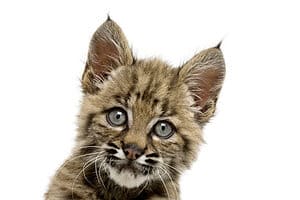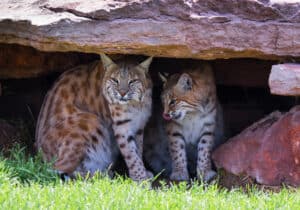- They are hunted and trapped for their fur.
- Bobcats have litters of 2-4 kittens each year.
Bobcats are found in the upper and western portions of Minnesota. They live in areas of dense vegetation and near water, with lots of prey nearby. They are excellent hunters and have just a few predators. Despite the small number of bobcats in Minnesota, the population has increased since the early 2000s and remained stable. Bobcats are similar in color to the two other species of native wildcats in the state.
All About Bobcats
Bobcats are one of the three types of wildcats that live in Minnesota. The other two are the Canada lynx and cougar. Bobcats are similar to both of these species, sharing very close physical features to the lynx. They are much smaller than lynxes, though, with smaller paws and no fur under their paws. This makes it a bit harder for them to live in areas where it’s extremely snowy.
Bobcats are also much smaller than their other wild relative — the cougar. While cougars are considered big cats, bobcats are not. The average male weighs around 30 pounds and the average female ranges from 20 to 25 pounds. They grow to around 26 to 36 inches long, not including their tail. They’re carnivores and are easily adaptable, eating a diet that ranges from mammals to birds, and even deer. They are also excellently skilled hunters, which is what allows them to take down adult deer.
Bobcats do not have the keenest sense of smell. They can’t see vivid colors or extreme details, but they do have an advantage in hunting in the later hours. In dim light, bobcats can see up to six times better than humans. Because of these abilities, they have the upper hand in the early mornings or late evenings. Unlike the lynx, which hunt at night, bobcats are crepuscular. This means that they are most active during twilight and dawn and sleep after midnight and during the heat of the day. This is most similar to their other relative — the cougar, which is considered nocturnal and crepuscular.
Where Do Bobcats Live in Minnesota
Minnesota is home to around 2,000 bobcats that live in the northwestern portion of the state. They prefer areas that offer a lot of coverage and warmth, especially if it’s during the winter season. Forests and areas with water are often a part of their territory because of the rich amount of prey. Bobcats usually like places with dense vegetation, as this makes stalking prey easier. They don’t have very high endurance and depend almost entirely on their attack and their needle-sharp teeth. This is why having coverage is key. They also like areas like this because they are safe places to build dens and raise their young.
Raising Their Young
Baby bobcats are usually born during the springtime, from March to May, in a litter. Females may give birth to a litter of two to four kittens. When prey is bountiful and the cats are in a safe location females can have up to six kittens. The kittens are then raised by the female bobcat, with the male moving on after breeding. They learn to hunt in the autumn and are then able to go their separate ways by the wintertime, or sometimes spring.
Bobcats are solitary animals and are very territorial. After leaving their siblings and mother, they almost always live on their own. Female bobcats generally occupy their own territories of about five square miles. Males occupy an area of around 30 square miles, often crossing over that of the females. This is what allows the males to mate with multiple females every year to keep the population alive.
Bobcat Population in Minnesota Today
The bobcat population has increased since the 1990s despite the fact there is a season for hunting and trapping them. In 2021-2022 there were 724 bobcats harvested through trapping, and 144 through hunting. The season for them is in the late winter and lasts about a month. They are most commonly harvested for their fur.
The DNR requires documentation of any trapping or killing of bobcats and gathers information on the animal. They ask where it was harvested, and its approximate age, weight, and length. The DNR then uses this information to create an annual survey and keep track of the population. They also ask for sightings to be reported as another means of keeping track of the bobcats.
Aside from humans, bobcats don’t have too many predators. They can be threatened by fishers and coyotes due to competition for land and food. Fishers and coyotes can kill the cats, but bobcats will also kill them given the chance. They don’t have any other common predators, which is likely why their population is able to be sustainable despite being so small.
The photo featured at the top of this post is © Don Mammoser/Shutterstock.com
Thank you for reading! Have some feedback for us? Contact the AZ Animals editorial team.






